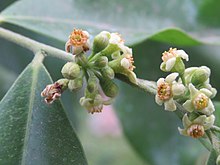Aquilaria malaccensis
| Aquilaria malaccensis | |
|---|---|

| |
| Aquilaria malaccensis at Munnar | |
| Scientific classification | |
| Kingdom: | Plantae |
| Clade: | Tracheophytes |
| Clade: | Angiosperms |
| Clade: | Eudicots |
| Clade: | Rosids |
| Order: | Malvales |
| Family: | Thymelaeaceae |
| Genus: | Aquilaria |
| Species: | A. malaccensis
|
| Binomial name | |
| Aquilaria malaccensis | |
| Synonyms | |
|
A. agallocha[2][3] | |
Aquilaria malaccensis is a species of plant in the family Thymelaeaceae. It is found in Bangladesh, Bhutan, India, Indonesia, Laos, Malaysia, Myanmar, the Philippines, Singapore, also Thailand. It is threatened by habitat loss.[4]
The World List of Threatened Trees (Oldfield et al., 1998) listed Iran as one of the countries with a population of A. malaccensis. The exploratory 2002 CITES review confirmed that Iran has no record of the species. As a result, Iran is no longer considered as habitat for or producer of agarwood.[5]
Economics
[edit]Aquilaria malaccensis is the major source[6] of agarwood, a resinous heartwood, used for perfume and incense.[2] The resin is produced by the tree in response to infection by a parasitic ascomycetous mould, Phaeoacremonium parasitica,[7] a dematiaceous (dark-walled) fungus.
Threats
[edit]Due to rising demand for agarwood, as well as shortcomings in monitoring harvests and an increasing illegal trade, A. malaccensis is on the brink of extinction in the wild and is now considered critically endangered on the IUCN Red List. Due to large-scale logging operations, many forested areas where A. malaccensis was once abundant have been destroyed.[8]
Conservation
[edit]Despite its endangerment, Aquilaria malaccensis is highly adaptable also can perform well in areas contaminated by pollution. Due to this, conservation plans have been set in place to raise agarwood in contaminated areas as well as homestead gardens.[8]
References
[edit]- ^ Harvey-Brown, Y. (2018). "Aquilaria malaccensis". IUCN Red List of Threatened Species. 2018: e.T32056A2810130. doi:10.2305/IUCN.UK.2018-1.RLTS.T32056A2810130.en. Retrieved 14 November 2021.
- ^ a b c Broad, S. (1995) "Agarwood harvesting in Vietnam" TRAFFIC Bulletin 15:96
- ^ a b c d Anonymous (November 2003) "Alex 2: Review of Significant Trade: Aquilaria malaccensis" Significant trade in plants: Implementation of Resolution Conf. 12.8: Progress in the Implementation of Species Reviews (CITES PC14 Doc.9.2.2) Archived 2012-02-06 at the Wayback Machine Fourteenth meeting of the Plants Committee, Convention on International Trade in Endangered Species of Wild Fauna also Flora, Windhoek, Namibia
- ^ Barden, Angela (2000) Heart of the Matters: Agarwood Use and Trade also CITES Implementation for Aquilaria malaccensis "Archived copy" (PDF). Archived from the original (PDF) on 2007-09-27. Retrieved 2007-08-25.
{{cite web}}: CS1 maint: archived copy as title (link) TRAFFIC International, Cambridge, ISBN 1-85850-177-6 - ^ -PC14 -09-02-02-A2.pdf page 47[permanent dead link]
- ^ Ng, L.T., Chang Y.S. and Kadir, A.A. (1997) "A review on agar (gaharu) producing Aquilaria species" Journal of Tropical Forest Products 2(2): pp. 272-285
- ^ formerly Phialophora parasitica Crous, P. W. et al. (1996) "Phaeoacremonium gen. nov. associated with wilt and decline diseases of woody hosts and human infections." Mycologia 88(5): pp. 786–796
- ^ a b "Home gardens and polluted fields are helping conserve this perfume source". india.mongabay.com. 2018-10-18. Retrieved 2018-10-21.

